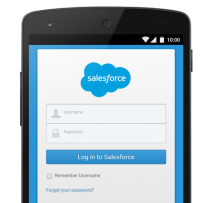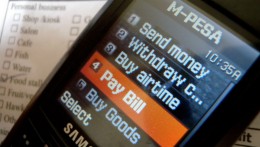
Image: Nomalys for Salesforce - Salesforce mobile app
Imagine this: the CEO of a Fortune 500 company is speaking on a panel at a conference. In his ten-minute taxi ride to the conference, he taps the SalesForce app on his mobile. Logging in, he’s able to check out whether his fellow panellists are current clients of his business – including their history of engagement with his company, whether they’ve bought, what events they’ve attended and more. Pulling up to the event, he’s able to open direct, frank and genial conversations with his co-panellists about their relationship with his business, easing the transition from stranger to acquaintance in less than 30 seconds.
This real situation, which happened last week at one of our events, encapsulates the vast allure that mobile technology holds for business leaders. It’s efficient, it’s – well, mobile, it’s practical, and it’s connected. Perhaps it’s for some of these reasons industry experts estimate that by 2018 annual sales will equate to 1.9 billion - that’s one smartphone for every five people on earth.
The smartphone is a super computer in your pocket, more powerful than those used to land Apollo 11 on the moon. It opens up incredible opportunities
Growing dependence on, and fondness for, mobile technology is prompting businesses to invest in mobile and think creatively about new, more efficient business practices. It’s even giving rise to entirely new markets, such as the apps for healthcare scene.
With the ubiquity of mobile technology in our everyday lives as consumers, from retail to wearables, companies are fast recognising the potential that mobile holds in creating a more customer centric experience, enabling better data management, equipping sales teams for remote business development opportunities, and exploring flexible working as more than simply a tick-box – effectively, in creating a more agile business.
Through behind the scenes tools such as apps and dashboards, there are many services on offer for businesses to choose from as they strategise for a mobile-enabled future. Below are a number of practical considerations and case studies that shed light on how mobile technology can bring competitive advantages to smart, forward-thinking enterprises of any size.
The Enterprise App
We’re living in the ‘application economy’, in which mobile apps have the potential to play a central role in profit making and cost cutting to get businesses closer to attaining a competitive advantage.
Bespoke enterprise apps are no longer the preserve of large corporations. As Matt Hunt, chief executive of Manchester-based developer Apadmi Enterprise explains, “It’s not always about big budgets, it’s about a mindset.” If decision-makers approach a project with the aim of developing a “minimum viable solution”, apps can be launched in a matter of weeks, with extra features and improvements added as user feedback comes in.
As well as the right attitude, businesses of all sizes must address the hurdle of integration, and ensure their existing back-end systems are ready for the leap to mobile.
“Organisations may have the ideas and see the opportunities, but they need to start by looking at their legacy systems,” says Mr Hunt. “Mistakes are made when companies go ahead with developing mobile, without having those integration points ready. Before we look at a mobile solution, we’ll always ask what it’s integrating with.”

Those who identify an opportunity, and carefully manage the move from a legacy system to an app-based solution, will reap the benefits. One success story comes from student accommodation provider Unite, who developed a custom app for its service engineers, replacing a paper-based process. The app boosted engineers’ productivity by 30 per cent and reduced the time it took the company to generate invoices from more than 45 days to under 15.
The average UK smartphone owner taps their screen over 215 times a day
Another advantage of the app, as opposed to the paper system, is that it gathers data on how and where work is carried out. This enables Unite to predict when common tasks that can be carried out by on-site staff will occur, avoiding the cost of an engineer visit.
What other kinds of apps are being developed to catalyse business? Marketing and sales are amongst the first teams to benefit. The introduction of programmatic buying, the automation of the purchasing of advertising inventory, for which business decisions are made in just milliseconds, and the advent of CRMs in app form are all unlocking potential for these departments.
Matt Brockhurst of Google’s product marketing and mobile advertising team hails mobile as an enabler; “it’s a super computer in your pocket, with more processing power than the computers we used to land Apollo 11 on the moon. It opens up incredible opportunities.”
Connected Retail
According to research by Zebra technologies, retailers think the internet of things will be the biggest change to hit the industry this decade. The surge in interest in mobile from retailers stems from mobile’s unique ability to increase business efficiency from targeting the right customers to guiding their purchasing journey to making it quick and convenient to make a payment.
However, whilst the technology is efficient, the monetisation prospects fall behind. As Sebastian Siemiatkowski from mobile payments platform Klarna explains, “of 100 people who click ‘buy’, only three finalise their purchase.” Part of the problem lies with optimisation and user experience. Brands are not yet fully optimised for mobile with usability issues ranging from badly designed homepages to issues with search despite the average UK smartphone owner tapping their screens over 215 times a day.

The in-store experience of tomorrow
Predictive analytics is stepping in to provide one possible solution to mobile monetisation issues for retail and ecommerce, modelling customers’ behaviour in their local supermarket and comparing it with real-time data on what similar consumers have purchased in a related store in order to predict their next move.
In-store, mobile is already being used to enhance customer experience with the release of Apple iBeacons. The iBeacons allow retailers to communicate with customers’ mobile phones as they step foot into the store, sending them personalised coupons, promotions and monitoring their in-store behaviour. Stores can also look forward to featuring customised messages on in-store displays in the not too distant future. Jason Lark, managing director of data marketing agency Celerity, predicts that incremental spend and margin could increase by almost 30 per cent.
Mobile is also in its element at the final stage of the retailing journey, optimising payment efficiency. Analyst firm Datamonitor reveals that $145.1 billion of sales in 2013 were paid for using mobile payments. The development of near-field-communication (NFC) technology has allowed Apple Pay, a proxy payment device containing cards which are held in a mobile wallet, to be rolled out in most stores. Expected to reach one billion users in the next few years, it’s one example of many opportunities for retailers to embrace mobile technology at a rapid pace to supercharge sales and service.
Mobile for finance
Banks are catching on to the idea of mobile banking as a means of efficiently capturing the attention of the fast-paced, no nonsense, millennial market and, like retail, are focusing on an increasingly mobile centric experience.
The first step to understanding the millennial mindset is to master the use of technology. As Alaistair Newton, vice president for research in banking at Gartner outlines, “the most used function on a smartphone is the camera. So banks could be looking at remote cheque deposit, where the customer takes a picture of the cheque.” Banks could also offer experience-driven services such as savings apps, offers based on location, digital wallets, peer-to-peer advice and lending advice via mobile.
The drawback is that mobile payments technologies can be disruptive - and costly - to implement. Built on a complex ecosystem requiring the proactive effort of multiple parties, there can easily be five or six different parties involved to process the payment in each transaction, not even including the retailer. Equally, with customers concerned especially with security issues regarding larger payments, there is an interface of fast-moving technology and relatively slow-moving consumer behaviour.
But it’s clear that the businesses that take the long-term view will reap the benefits in the long run. Researchers at Deloitte predict that the proportion of mobile payments will increase by a staggering 1,100 per cent worldwide in 2015, albeit from a low base.
Jonathan Vaux, executive director for new digital payments and strategy at Visa Europe, rightly comments: “For people of my generation, a smartphone is comparatively new technology and we have had plastic longer than we have had smartphones. But my son is 13, and he had a smartphone before he had a debit card or any financial instrument - so a lot of his learnt intuitive behaviours are driven by interaction with the phone. ” This generational effect looks set to make mobile payments a normal part of everyday life in the not too distant future.

As with any new technology, the “What do I get out of it?” for the consumer has to be the leading factor. For any new payments technology to succeed, it has to be quicker, easier and safer, or offer a substantial inducement. “Once people can walk into a hotel, use their phone to pay for a room in a fully automated manner so the room is allocated and the phone can function as the room door key using NFC, then interest will increase,” says Paul Lee, partner at Deloitte.
Case Study: M Pesa

M-Pesa has inspired enormous change in a country where only 2.5 million people had bank accounts
Bill Gates in his 2015 newsletter made a prediction that “the lives of people in poor countries will improve faster in the next 15 years than at any other time in history,” and mobile banking is at the top of the list when it comes to achieving this goal.
M-Pesa, a mobile payments service launched in Kenya in 2007, has inspired enormous change in a country with a population of 40 million where only 2.5 million people had bank accounts. In 2015, $2 out of every $5 transferred, 40 per cent of GDP, is moved through mobiles.
The trusted M-Pesa agents record the money transferred via text messaging sans hefty transfer fees and the result is almost universal access to the financial system. The Consultative Group to Assist the Poor estimates that in 2008, less than 20 per cent of the population living on less than $1.25 a day utilised financial services in 2008 and this figure has grown to 72 per cent with the introduction of M-Pesa and related mobile financial services providers.
See other Raconteur Guides for Business: “Managing Millennials”

The Enterprise App

